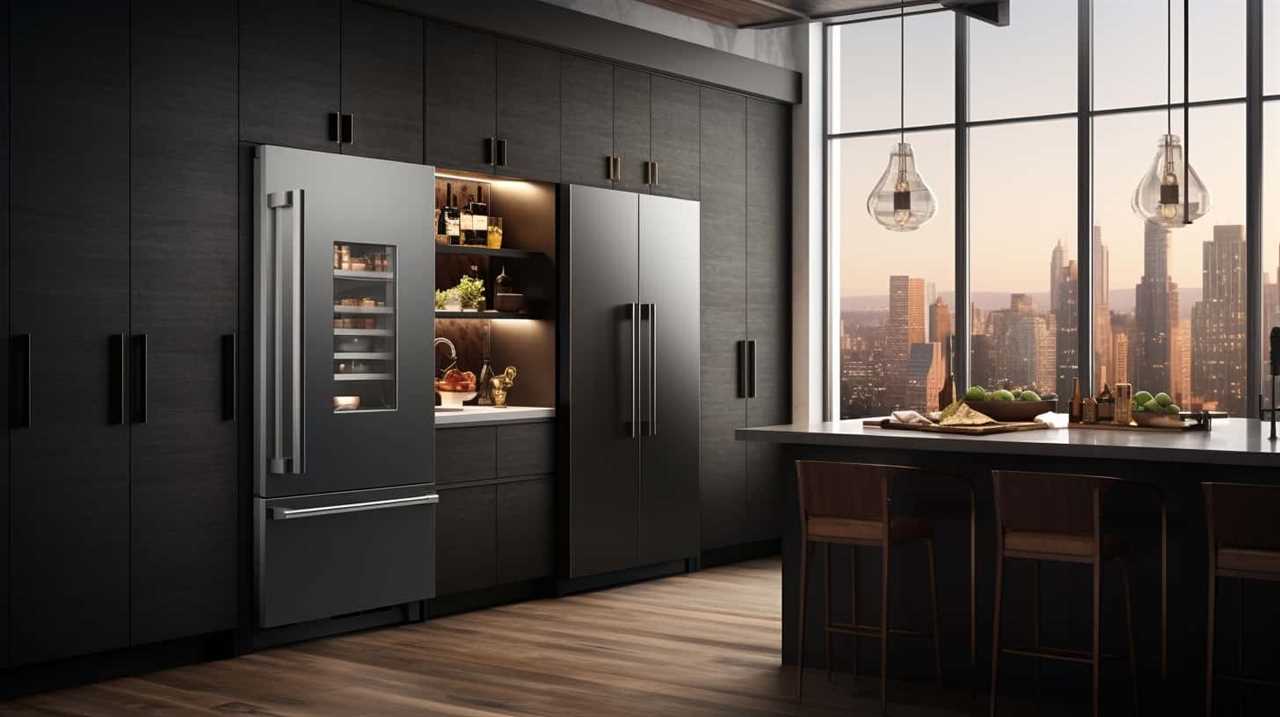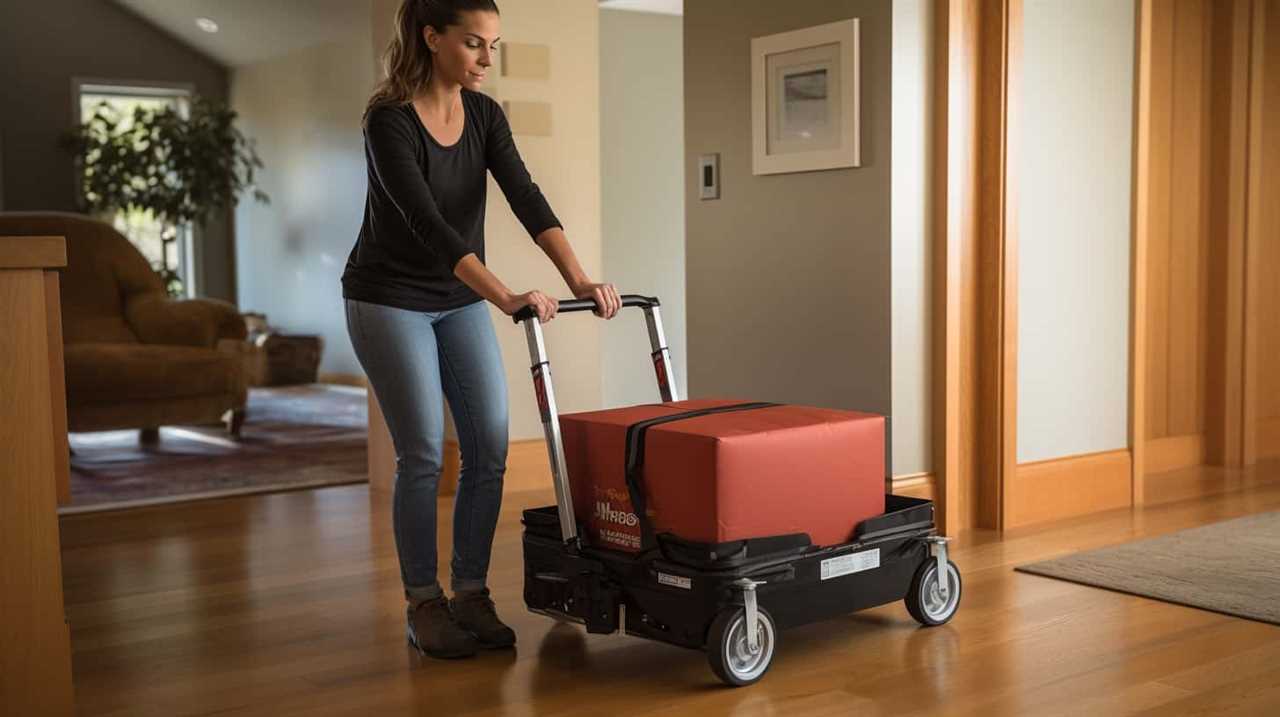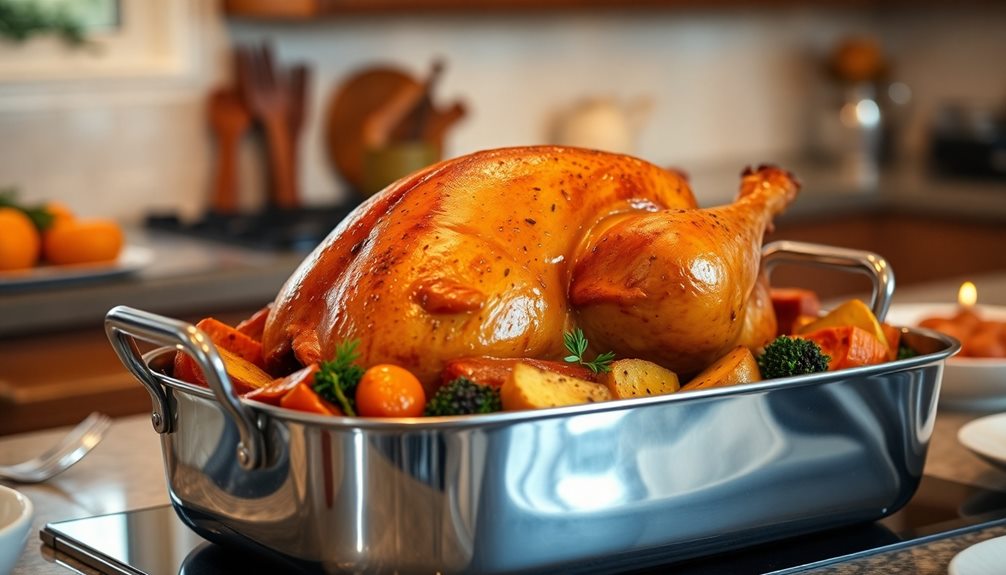Are your energy bills on the rise? Do not worry, as we have the perfect guide to help increase your home’s energy efficiency with appliances!
In this article, we will share 9 valuable tips that will help you master the art of energy conservation.
From upgrading to Energy Star-rated appliances to optimizing refrigerator and freezer settings, we’ve got you covered.
Discover the secrets of using energy-efficient cooking methods and maximizing dishwasher efficiency.

We’ll also guide you in selecting low-energy lighting options and reducing standby power consumption.
Proper maintenance and cleaning of your appliances are essential, and we’ll show you how.
Plus, we’ll delve into the world of smart home technology for energy savings and explore energy-efficient laundry practices.
Get ready to revolutionize your energy consumption and save big!

Key Takeaways
- Upgrade to Energy Star-rated appliances
- Use cold water for washing clothes
- Opt for a front-loading washing machine
- Air dry clothes instead of using a dryer
Upgrade to Energy Star-Rated Appliances
We frequently upgrade to Energy Star-rated appliances for our home to maximize energy efficiency. Energy Star-rated appliances are designed to consume less energy and reduce greenhouse gas emissions.
When it comes to laundry, using energy-saving techniques can make a significant difference. Washing clothes in cold water instead of hot water can save up to 90% of the energy used for washing. Additionally, opting for a front-loading washing machine can save water and electricity compared to top-loading machines. Another energy-saving laundry tip is to air dry clothes whenever possible. This not only saves energy but also helps preserve the quality of your clothes.
In terms of dishwashing, eco-friendly methods can also contribute to energy efficiency. Using the dishwasher only when it’s full can help save water and energy. Additionally, scrape off excess food from dishes instead of pre-rinsing them to reduce water usage. Choosing the energy-saving mode on your dishwasher can also make a difference.
Optimize Refrigerator and Freezer Settings
Let’s talk about how to optimize the settings of your refrigerator and freezer to boost home energy efficiency.

First, make sure to set the temperature controls at the recommended levels (around 37-40°F for the refrigerator and 0-5°F for the freezer).
Additionally, take advantage of energy-saving settings like the power-saving mode or vacation mode when you’re away for an extended period.
Lastly, don’t forget to perform regular maintenance tasks such as cleaning the condenser coils and checking the door seals for proper insulation.
Temperature Control Tips
To maximize energy efficiency in our home appliances, it is important to optimize the settings of our refrigerator and freezer. By implementing temperature control strategies, we can ensure that our appliances are running efficiently and using the least amount of energy possible. Here are some tips to help you optimize the settings of your refrigerator and freezer:

| Temperature Setting | Refrigerator | Freezer |
|---|---|---|
| Ideal Setting | 37°F | 0°F |
| Keep it Consistent | Avoid frequent temperature adjustments as it can lead to energy waste. | |
| Check the Seals | Make sure the door seals are tight, preventing cold air from escaping and warm air from entering. |
Energy-Saving Settings
To optimize the energy efficiency of our refrigerator and freezer, we can adjust the settings to maximize their performance.
One energy-saving tip is to set the refrigerator’s temperature between 36 and 38 degrees Fahrenheit (2 to 3 degrees Celsius) and the freezer’s temperature between 0 and 5 degrees Fahrenheit (-18 to -15 degrees Celsius). These settings ensure that our food stays fresh while minimizing energy consumption.
Additionally, it’s important to regularly clean the condenser coils at the back of the fridge to remove dust and debris, as this can improve overall performance and reduce energy usage.
By implementing these energy-saving settings and maintaining our appliances properly, we can ensure that our refrigerators and freezers operate efficiently, saving energy and reducing our environmental impact.

Now, let’s move on to the next section about proper fridge maintenance.
Proper Fridge Maintenance
To ensure optimal performance and energy efficiency of our refrigerator and freezer, we must prioritize proper maintenance, including optimizing the settings for both appliances.
Here are three key tips to help you maintain an energy-saving food storage system and make eco-friendly fridge upgrades:
- Set the temperature correctly: Keep your refrigerator temperature between 37 and 40 degrees Fahrenheit (3 to 4 degrees Celsius) and your freezer at 0 degrees Fahrenheit (-18 degrees Celsius). This ensures that your food stays fresh while minimizing energy consumption.
- Check the door seals: Over time, the door seals can become worn or damaged, leading to energy loss. Make sure the seals are clean and tight to prevent cool air from escaping.
- Keep the coils clean: Dust and dirt can accumulate on the condenser coils, reducing their efficiency. Regularly vacuum or brush the coils to improve energy performance.
Use Energy-Efficient Cooking Methods
We opt for energy-efficient cooking methods to maximize home energy efficiency with our appliances. Two great options to consider are induction cooking and solar ovens.

Induction cooking is a highly efficient method that uses electromagnetic fields to directly heat the cookware. Unlike traditional gas or electric stoves, induction cooktops heat up quickly and provide instant control over the temperature. They’re also more energy-efficient because they only heat the cookware and not the surrounding area. This means less wasted heat and a more efficient cooking process overall.
Solar ovens are another eco-friendly option. They use the power of the sun to cook food, eliminating the need for electricity or gas. Solar ovens work by trapping sunlight and converting it into heat, allowing you to bake, roast, or steam your meals without any emissions or additional energy costs. They’re particularly useful in sunny climates or during the summer months when the sun’s rays are strongest.
Maximize Dishwasher Efficiency
Let’s talk about maximizing dishwasher efficiency.
One way to do this is by opting for water-saving dishwasher options, which can help reduce water consumption while still delivering effective cleaning results.

Additionally, investing in energy-efficient dishwasher models can save both energy and water, helping to lower utility bills and minimize environmental impact.
Water-Saving Dishwasher Options
Maximizing dishwasher efficiency can be achieved through the use of water-saving options. When it comes to eco-friendly dishwashing techniques and water-efficient dishwasher models, here are three key strategies to consider:
- Opt for a dishwasher with a high Energy Star rating: Look for models that are specifically designed to use less water and energy, while still delivering effective cleaning performance. These dishwashers often come with advanced features like soil sensors and targeted spray jets, ensuring that every load is cleaned efficiently.
- Use the appropriate wash cycle: Many modern dishwashers offer different wash cycle options, such as eco or light wash. By selecting the right cycle for each load, you can conserve water and energy without compromising cleanliness. Be mindful of the level of soiling and choose the most efficient cycle accordingly.
- Load the dishwasher efficiently: Make sure to load your dishwasher properly to maximize its capacity and minimize the number of cycles needed. Avoid overcrowding and ensure that dishes are properly arranged for optimal water flow. Refer to the dishwasher manual for guidance on how to load different types of items for best results.
By implementing these water-saving options, you can’t only reduce your environmental impact but also save money on your utility bills.
Now, let’s explore the next section about energy-efficient dishwasher models.

Energy-Efficient Dishwasher Models
To further enhance our efforts in conserving energy and water, it’s essential to explore energy-efficient dishwasher models that maximize efficiency.
When it comes to energy efficient dishwasher features, look for models with an ENERGY STAR certification. These dishwashers are designed to use less water and energy, saving you money on your utility bills.
Additionally, consider dishwashers with advanced water saving dishwasher technology, such as sensors that adjust the water usage based on the load size and soil level.
Look for models with high energy efficiency ratings and low water consumption.

By investing in an energy-efficient dishwasher, you can reduce your environmental impact and save money in the long run.
Choose Low-Energy Lighting Options
We can save energy in our homes by opting for low-energy lighting options. Choosing energy-efficient light bulbs not only reduces our electricity bills but also helps to protect the environment. Here are three reasons why LED lighting is a great choice for energy savings:
- LED lighting benefits: LED bulbs are highly energy-efficient compared to traditional incandescent bulbs. They use up to 80% less energy, which means lower electricity costs. LED bulbs also have a longer lifespan, lasting up to 25 times longer than incandescent bulbs. This means less frequent replacements and less waste.
- Energy saving light bulbs: Energy-saving bulbs, such as compact fluorescent lamps (CFLs), are another excellent choice for reducing energy consumption. They use about 75% less energy than incandescent bulbs and last up to 10 times longer. CFLs provide the same level of brightness but at a fraction of the energy usage.
- Environmental impact: Opting for low-energy lighting options significantly reduces carbon emissions and lowers our overall environmental footprint. By using LED bulbs or energy-saving CFLs, we contribute to a more sustainable future and help combat climate change.
By choosing low-energy lighting options, we not only save money on our energy bills but also make a positive impact on the planet.
Now, let’s move on to the next section and explore how we can further reduce standby power consumption.

Reduce Standby Power Consumption
While it may seem insignificant, reducing standby power consumption can have a significant impact on our overall home energy efficiency. Standby power refers to the energy consumed by appliances and electronics when they’re turned off but still plugged in. These devices can continue to draw power even when not in use, contributing to unnecessary energy waste and higher electricity bills.
One effective way to reduce standby power consumption is by using smart power strips. These power strips are designed to cut off power to devices that are in standby mode or not being used. By connecting multiple devices to a single power strip and turning off the strip when not in use, you can eliminate standby power consumption altogether.
Another solution is to use energy-efficient power adapters. These adapters are designed to consume less energy when devices aren’t in use. Look for adapters with high energy efficiency ratings and consider replacing old adapters with newer, more efficient models.
By implementing these simple yet effective measures, we can significantly reduce standby power consumption in our homes and improve our overall energy efficiency.

Now, let’s move on to the next section and explore how properly maintaining and cleaning appliances can further enhance energy efficiency.
Properly Maintain and Clean Appliances
Maintaining and cleaning appliances regularly is essential for maximizing their energy efficiency and prolonging their lifespan. By following simple cleaning routines and conducting regular appliance inspections, you can ensure that your appliances are running efficiently and effectively.
Here are three key steps to help you maintain and clean your appliances:
- Clean the filters: Dirty filters can restrict airflow and reduce the efficiency of appliances such as air conditioners, refrigerators, and vacuum cleaners. Regularly clean or replace filters to keep them functioning at their best.
- Dust off coils and vents: Dust and debris can accumulate on coils, vents, and condenser fins, leading to decreased performance and increased energy consumption. Use a soft brush or vacuum cleaner to remove dirt and dust from these areas to improve efficiency.
- Check and tighten connections: Loose or faulty connections can affect the performance of appliances, causing them to use more energy. Regularly inspect and tighten electrical connections and ensure that seals and gaskets are intact to prevent air leaks.
Utilize Smart Home Technology for Energy Savings
To further enhance our home energy efficiency and maximize the benefits of our appliances, we can take advantage of smart home technology for energy savings. Smart home automation allows us to control and monitor our appliances remotely, making it easier to optimize their energy usage. By connecting our appliances to a central hub or through Wi-Fi, we can schedule and adjust their settings according to our preferences and energy-saving goals.

One of the key features of smart home automation is the ability to integrate energy monitoring systems. These systems provide real-time data on our energy consumption, allowing us to identify areas where we can reduce waste and save on our utility bills. With this information at our fingertips, we can make informed decisions about when to run our appliances and how to minimize their energy usage.
By utilizing smart home technology, we can create a more energy-efficient home environment. Whether it’s adjusting our thermostat remotely, turning off lights automatically when not in use, or receiving alerts about excessive energy usage, smart home automation empowers us to take control of our energy consumption.
Now that we understand the benefits of smart home technology for energy savings, let’s explore another area where we can make a difference: considering energy-efficient laundry practices.
Consider Energy-Efficient Laundry Practices
For efficient laundry practices, we can implement a high-efficiency washer and dryer. These energy-efficient washing machines are designed to use less water and electricity, helping us reduce our carbon footprint while saving money on utility bills.

Here are three eco-friendly laundry practices to consider:
- Use cold water: Washing clothes in cold water instead of hot or warm water can significantly reduce energy consumption. Around 90% of the energy used by a washing machine goes towards heating the water. By opting for cold water, we can save energy and still achieve clean clothes.
- Full loads only: Make sure to fill the washing machine to its maximum capacity before running a cycle. Running small loads wastes water and energy. By waiting until we’ve a full load, we can maximize the efficiency of each wash.
- Air dry whenever possible: Instead of relying on the dryer, consider air drying clothes whenever possible. The dryer consumes a significant amount of electricity, so by hanging clothes outside or using drying racks indoors, we can save energy and even extend the lifespan of our clothes.
Frequently Asked Questions
How Do I Know if My Current Appliances Are Energy Star-Rated?
To know if our current appliances are energy star-rated, we can look for the energy star label on the product or check the manufacturer’s website for the specifications. Energy star-rated appliances are designed to be more energy efficient, which means they use less electricity and can help reduce our energy bills.
What Are Some Energy-Efficient Cooking Methods That I Can Use?
What are some energy-efficient cooking methods that we can use?
One option is induction cooking, which uses electromagnetic fields to heat the cookware directly, resulting in faster and more efficient cooking.

Another method is slow cooking, which uses low temperatures over a longer period of time, reducing energy usage.
Can I Save Energy by Adjusting the Settings on My Refrigerator and Freezer?
Yes, we can save energy by adjusting the settings on our refrigerator and freezer.
By optimizing the refrigerator settings, such as setting the temperature between 35 to 38 degrees Fahrenheit, we can reduce energy consumption.
Likewise, adjusting the freezer temperature to around 0 degrees Fahrenheit can also help save energy.

Additionally, keeping both appliances well-maintained, defrosting regularly, and ensuring proper door seals can further maximize energy efficiency.
These small adjustments can make a big difference in reducing our energy usage.
How Can I Reduce Standby Power Consumption in My Home?
Reducing vampire power consumption in our homes is an essential step towards energy efficiency.
One effective way to accomplish this is by using energy-saving power strips. These power strips are equipped with features that prevent standby power consumption when devices aren’t in use.

By simply turning off the power strip, we can eliminate the energy wasted by appliances in standby mode.
This small change can make a big difference in reducing our overall energy consumption and saving money on our electricity bills.
What Are Some Smart Home Technologies That Can Help Me Save Energy With My Appliances?
Smart thermostats and energy monitoring systems are two smart home technologies that can help us save energy with our appliances.
By using a smart thermostat, we can easily control the temperature of our home and optimize energy usage.

Energy monitoring systems allow us to track our energy consumption and identify areas where we can make improvements.
These technologies empower us to make informed decisions and take action to increase our home’s energy efficiency.
How Can Using Energy-Efficient Appliances Save Money in the Long Term?
Investing in energy-efficient appliances can lead to significant savings in the long run. By following tips for energy-efficient appliances such as selecting models with the Energy Star label and using appliances during off-peak hours, you can lower your utility bills and reduce your overall energy consumption.
Conclusion
In our quest for a more energy-efficient home, we’ve discovered the power of small changes. By upgrading to Energy Star-rated appliances, optimizing settings, and using low-energy lighting options, we can make a significant impact on our energy consumption.
With proper maintenance and the help of smart home technology, we can further reduce our energy usage.

Let’s embrace these practices and symbolize our commitment to a greener, more sustainable future. Together, we can make a difference.










